Water Area Variation and River–Lake Interactions in the Poyang Lake from 1977–2021
Abstract
:1. Introduction
2. Study Area and Data
2.1. Study Area
2.2. Data Collection
3. Methods
3.1. Extraction Method of Water Area
3.2. Statistical Analysis
4. Results
4.1. Trends and Change Point of Lake Water Area
4.2. Analysis of Lake Water Area Impact Factor
4.2.1. Changes in the Lake Flow
4.2.2. Changes in the Poyang Lake Sediment Load
4.2.3. Changes in the Pan Evaporation and Precipitation in the Poyang Lake
4.2.4. Results of Principal Component Analysis
4.2.5. Land Use Changes in the Poyang Lake
5. Discussion
5.1. Influence Mechanism of Lake Water Area Change in Flood Season
- The Poyang Lake basin’s dominant inflow period is from December–March, whereby runoff into the Poyang Lake basin increases and the lake water level rises.
- The river–lake interaction period is from April–August when the mainstream of the Yangtze River begins to rise and the water level in Poyang Lake is also high. The high water level of the Yangtze River causes a blocking effect on the outflows from the Poyang Basin. Runoff from the Poyang Basin cannot flow out, resulting in flood stagnation in the lake and water area expansion.
- The Yangtze River runoff dominant period is from September–November, wherein, influenced by the upstream Yangtze River, runoff from the Yangtze River increases and the water level rises. The runoff from the Yangtze River flows into the Poyang Lake through the estuary.
5.2. Influence Mechanism of Lake Water Area Change in Dry Season
5.3. Implications for Water Management in the Poyang Lake
6. Conclusions
- During the flood seasons of the study period, the lake water area showed a significant decreasing trend, with an average annual size decrease of −9.14 km2. In the dry season, the lake water area showed a significant downward trend, measuring a decrease rate of −17.52 km2/a. In addition, it was determined that the change point years of the flood season and dry season water areas were 2005 and 2003, respectively.
- Lake runoff, sediment load, and precipitation significantly correlate with the flood season water area. In the dry season, the sediment load significantly correlates with the water area.
- The analysis of satellite imagery confirmed a direct correlation between the change in the water area and the change in the net outflow of the lake in the flood season, and the net outflow is affected by the river–lake interactions. The Poyang Lake is a classical river-connected drain lake. Flood or drought events in the mainstream of the Yangtze River will affect the blocking or reversing of the Yangtze River on the Poyang Lake estuary, impacting the net outflow of the lake and altering the water area.
- In the dry season, the sediment load deposition at the elevation of the estuarine entrance lakebed was raised, especially at the Ganjiang river estuary, affecting the water’s body shape. However, after 2000, the TGD water impoundment operation on the upper Yangtze River affected the runoff of the lower reaches of the Yangtze River at the end of the flood season. This impacted the river–lake interaction and decreased the area of Poyang Lake.
Author Contributions
Funding
Data Availability Statement
Conflicts of Interest
References
- Zhang, Q.; Liu, Y.; Yao, J.; Lai, X.; Li, X.; Wu, G.; Huang, Q.; Sun, Z.; Li, Y.; Tan, Z.; et al. Lake Hydrology in China: Advances and Prospects. J. Lake Sci. 2020, 32, 1360–1379. [Google Scholar] [CrossRef]
- Vaheddoost, B.; Aksoy, H. Interaction of Groundwater with Lake Urmia in Iran. Hydrol. Process. 2018, 32, 3283–3295. [Google Scholar] [CrossRef]
- Rosenberry, D.O.; Lewandowski, J.; Meinikmann, K.; Nützmann, G. Groundwater–the Disregarded Component in Lake Water and Nutrient Budgets. Part 1: Effects of Groundwater on Hydrology. Hydrol. Process. 2015, 29, 2895–2921. [Google Scholar] [CrossRef]
- Lima-Quispe, N.; Escobar, M.; Wickel, A.J.; von Kaenel, M.; Purkey, D. Untangling the Effects of Climate Variability and Irrigation Management on Water Levels in Lakes Titicaca and Poopó. J. Hydrol. Reg. Stud. 2021, 37, 100927. [Google Scholar] [CrossRef]
- Huang, A.; Liu, X.; Peng, W.; Dong, F.; Ma, B.; Li, J.; Wang, W. Spatiotemporal Characteristics, Influencing Factors and Evolution Laws of Water Exchange Capacity of Poyang Lake. J. Hydrol. 2022, 609, 127717. [Google Scholar] [CrossRef]
- Zhang, G.; Yao, T.; Xie, H.; Yang, K.; Zhu, L.; Shum, C.K.; Bolch, T.; Yi, S.; Allen, S.; Jiang, L.; et al. Response of Tibetan Plateau Lakes to Climate Change: Trends, Patterns, and Mechanisms. Earth-Sci. Rev. 2020, 208, 103269. [Google Scholar] [CrossRef]
- Zhang, Y.; Xie, C.; Wu, T.; Zhao, L.; Pang, Q.; Wu, J.; Yang, G.; Wang, W.; Zhu, X.; Wu, X.; et al. Permafrost Degradation Is Accelerating beneath the Bottom of Yanhu Lake in the Hoh Xil, Qinghai-Tibet Plateau. Sci. Total Environ. 2022, 838, 156045. [Google Scholar] [CrossRef]
- Woolway, R.I.; Verburg, P.; Merchant, C.J.; Lenters, J.D.; Hamilton, D.P.; Brookes, J.; Kelly, S.; Hook, S.; Laas, A.; Pierson, D.; et al. Latitude and Lake Size Are Important Predictors of Over-Lake Atmospheric Stability. Geophys. Res. Lett. 2017, 44, 8875–8883. [Google Scholar] [CrossRef] [Green Version]
- Li, H.; Luo, Z.; Xu, Y.; Zhu, S.; Chen, X.; Geng, X.; Xiao, L.; Wan, W.; Cui, Y. A Remote Sensing-Based Area Dataset for Approximately 40 Years That Reveals the Hydrological Asynchrony of Lake Chad Based on Google Earth Engine. J. Hydrol. 2021, 603, 126934. [Google Scholar] [CrossRef]
- Hu, Q.; Feng, S.; Guo, H.; Chen, G.; Jiang, T. Interactions of the Yangtze River Flow and Hydrologic Processes of the Poyang Lake, China. J. Hydrol. 2007, 347, 90–100. [Google Scholar] [CrossRef]
- Wang, R.; Li, X.; Xue, C.; Zhang, D. Spatio-temporal variations of the drought-flood abrupt alternation events in the Lake Poyang Basin from 1960 to 2012. J. Lake Sci. 2020, 32, 207–222. [Google Scholar] [CrossRef] [Green Version]
- Liu, W.; Zhu, S.; Huang, Y.; Wan, Y.; Wu, B.; Liu, L. Spatiotemporal Variations of Drought and Their Teleconnections with Large-Scale Climate Indices over the Poyang Lake Basin, China. Sustainability 2020, 12, 3526. [Google Scholar] [CrossRef]
- Lai, X.; Jiang, J.; Yang, G.; Lu, X.X. Should the Three Gorges Dam Be Blamed for the Extremely Low Water Levels in the Middle-Lower Yangtze River? Hydrol. Process. 2014, 28, 150–160. [Google Scholar] [CrossRef]
- Zhang, Q.; Ye, X.; Werner, A.D.; Li, Y.; Yao, J.; Li, X.; Xu, C. An Investigation of Enhanced Recessions in Poyang Lake: Comparison of Yangtze River and Local Catchment Impacts. J. Hydrol. 2014, 517, 425–434. [Google Scholar] [CrossRef] [Green Version]
- Yao, J.; Gao, J.; Yu, X.; Zhang, Q. Impacts of a Proposed Water Control Project on the Inundation Regime in China’s Largest Freshwater Lake (Poyang Lake): Quantification and Ecological Implications. J. Hydrol. Reg. Stud. 2022, 40, 101024. [Google Scholar] [CrossRef]
- Meng, J.-N.; Fang, H.; Huang, L.; He, G.; Liu, X.; Xu, C.; Wu, X.; Scavia, D. Multidimensional Ecosystem Assessment of Poyang Lake under Anthropogenic Influences. Ecol. Model. 2022, 473, 110134. [Google Scholar] [CrossRef]
- Lei, X.; Gao, L.; Wei, J.; Ma, M.; Xu, L.; Fan, H.; Li, X.; Gao, J.; Dang, H.; Chen, X.; et al. Contributions of Climate Change and Human Activities to Runoff Variations in the Poyang Lake Basin of China. Phys. Chem. Earth Parts A/B/C 2021, 123, 103019. [Google Scholar] [CrossRef]
- Sene, K.J. Effect of Variations in Net Basin Supply on Lake Levels and Outflows. Hydrol. Process. 1998, 12, 559–573. [Google Scholar] [CrossRef]
- Palmer, S.C.J.; Kutser, T.; Hunter, P.D. Remote Sensing of Inland Waters: Challenges, Progress and Future Directions. Remote Sens. Environ. 2015, 157, 1–8. [Google Scholar] [CrossRef] [Green Version]
- Arabi, B.; Salama, M.S.; Pitarch, J.; Verhoef, W. Integration of In-Situ and Multi-Sensor Satellite Observations for Long-Term Water Quality Monitoring in Coastal Areas. Remote Sens. Environ. 2020, 239, 111632. [Google Scholar] [CrossRef]
- Zan, Y.; Gao, Y.; Jiang, Y.; Pan, Y.; Li, X.; Su, P. The Effects of Lake Level and Area Changes of Poyang Lake on the Local Weather. Atmosphere 2022, 13, 1490. [Google Scholar] [CrossRef]
- Wang, Z. Variation of Lake-River-Aquifer Interactions Induced by Human Activity and Climatic Condition in Poyang Lake Basin, China. J. Hydrol. 2021, 595, 126058. [Google Scholar] [CrossRef]
- Li, Y.; Zhang, Q.; Werner, A.D.; Yao, J.; Ye, X. The Influence of River-to-Lake Backflow on the Hydrodynamics of a Large Floodplain Lake System (Poyang Lake, China): Influence of River Backflow on the Hydrodynamics of a Floodplain Lake. Hydrol. Process. 2017, 31, 117–132. [Google Scholar] [CrossRef]
- Min, Q.; Zhan, L. Characteristics of Low-Water Level Changes in Lake Poyang during 1952–2011. J. Lake Sci. 2012, 24, 675–678. [Google Scholar] [CrossRef] [Green Version]
- Liu, H.; Zheng, L.; Jiang, L.; Liao, M. Forty-Year Water Body Changes in Poyang Lake and the Ecological Impacts Based on Landsat and HJ-1 A/B Observations. J. Hydrol. 2020, 589, 125161. [Google Scholar] [CrossRef]
- Zhang, D.; Hong, H.; Zhang, Q.; Nie, R. Effects of Climatic Variation on Pan-Evaporation in the Poyang Lake Basin, China. Clim. Res. 2014, 61, 29–40. [Google Scholar] [CrossRef]
- Gocic, M.; Trajkovic, S. Analysis of Changes in Meteorological Variables Using Mann-Kendall and Sen’s Slope Estimator Statistical Tests in Serbia. Glob. Planet. Chang. 2013, 100, 172–182. [Google Scholar] [CrossRef]
- Nyikadzino, B.; Chitakira, M.; Muchuru, S. Rainfall and Runoff Trend Analysis in the Limpopo River Basin Using the Mann Kendall Statistic. Phys. Chem. Earth Parts A/B/C 2020, 117, 102870. [Google Scholar] [CrossRef]
- Hamed, K.H. Exact Distribution of the Mann–Kendall Trend Test Statistic for Persistent Data. J. Hydrol. 2009, 365, 86–94. [Google Scholar] [CrossRef]
- Mann, H. Non-Parametric Test Against Trend. Econometrica 1945, 13, 245–259. [Google Scholar] [CrossRef]
- Kendall, M.G. Rank Correlation Method. Biometrika 1957, 44, 298. [Google Scholar] [CrossRef]
- Ouyang, Y.; Nkedi-Kizza, P.; Wu, Q.T.; Shinde, D.; Huang, C.H. Assessment of Seasonal Variations in Surface Water Quality. Water Res. 2006, 40, 3800–3810. [Google Scholar] [CrossRef] [PubMed]
- Olsen, R.L.; Chappell, R.W.; Loftis, J.C. Water Quality Sample Collection, Data Treatment and Results Presentation for Principal Components Analysis–Literature Review and Illinois River Watershed Case Study. Water Res. 2012, 46, 3110–3122. [Google Scholar] [CrossRef]
- Betancur, S.B.; Gastmans, D.; Vásquez, K.V.; Santarosa, L.V.; dos Santos, V.; Kirchheim, R.E. Hydrological Responses in Equatorial Watersheds Indicated by Principal Components Analysis (PCA)–Study Case in Atrato River Basin (Colombia). RBRH 2020, 25, e45. [Google Scholar] [CrossRef]
- Pontius, R.G.; Shusas, E.; McEachern, M. Detecting Important Categorical Land Changes While Accounting for Persistence. Agric. Ecosyst. Environ. 2004, 101, 251–268. [Google Scholar] [CrossRef]
- Li, X.; Zhang, Q.; Xu, C.-Y.; Ye, X. The Changing Patterns of Floods in Poyang Lake, China: Characteristics and Explanations. Nat. Hazards 2015, 76, 651–666. [Google Scholar] [CrossRef]
- Shankman, D.; Keim, B.D.; Song, J. Flood Frequency in China’s Poyang Lake Region: Trends and Teleconnections. Int. J. Clim. 2006, 26, 1255–1266. [Google Scholar] [CrossRef] [Green Version]
- Ye, X. Changes of Extreme Precipitation and Possible Influence of ENSO Events in a Humid Basin in China. Atmosphere 2021, 12, 1522. [Google Scholar] [CrossRef]
- Wang, H.; Kaisam, J.P.; Liang, D.; Deng, Y.; Shen, Y. Wind Impacts on Suspended Sediment Transport in the Largest Freshwater Lake of China. Hydrol. Res. 2020, 51, 815–832. [Google Scholar] [CrossRef]
- Lai, X.; Shankman, D.; Huber, C.; Yesou, H.; Huang, Q.; Jiang, J. Sand Mining and Increasing Poyang Lake’s Discharge Ability: A Reassessment of Causes for Lake Decline in China. J. Hydrol. 2014, 519, 1698–1706. [Google Scholar] [CrossRef]
- Yao, J.; Li, Y.; Li, M.; Zhang, Q. The Influence of Bathymetry Changes on Low Water Level of Lake Poyang. J. Lake Sci. 2017, 29, 955–964. [Google Scholar] [CrossRef] [Green Version]
- Ye, X.; Li, Y.; Li, X.; Zhang, Q. Factors Influencing Water Level Changes in China’s Largest Freshwater Lake, Poyang Lake, in the Past 50 Years. Water Int. 2014, 39, 983–999. [Google Scholar] [CrossRef]
- Li, M.; Zhang, Q.; Li, Y.; Yao, J.; Tan, Z. Inter-Annual Variations of Poyang Lake Area during Dry Seasons: Characteristics and Implications. Hydrol. Res. 2016, 47, 40–50. [Google Scholar] [CrossRef] [Green Version]
- Chen, M.; Fan, S.; Deng, J.; Wang, X. Impact of the Three Gorges Dam on Regulation and Storage Capacity of Poyang Lake. J. Landsc. Res. 2020, 12, 50–55. [Google Scholar]
- Huang, S.; Xia, J.; Zeng, S.; Wang, Y.; She, D. Effect of Three Gorges Dam on Poyang Lake Water Level at Daily Scale Based on Machine Learning. J. Geogr. Sci. 2021, 31, 1598–1614. [Google Scholar] [CrossRef]
- You, H.; Xu, L.; Jiang, J.; Wang, X.; Huang, Q.; Liu, G. The Effects of Water Level Fluctuations on the Wetland Landscape and Waterfowl Habitat of Poyang Lake. Fresenius Environ. Bull. 2014, 23, 1650–1661. [Google Scholar]
- Hu, B.; Zou, L.; Qi, S.; Yin, Q.; Luo, J.; Zuo, L.; Meng, Y. Evaluating the Vulnerability of Siberian Crane Habitats and the Influences of Water Level Intervals in Poyang Lake Wetland, China. Remote Sens. 2022, 14, 2774. [Google Scholar] [CrossRef]
- Li, H.; Zhang, H.; Yu, L.; Cao, K.; Wang, D.; Duan, X.; Ding, F.; Mao, Z.; Wang, K.; Liu, S.; et al. Managing Water Level for Large Migratory Fish at the Poyang Lake Outlet: Implications Based on Habitat Suitability and Connectivity. Water 2022, 14, 2076. [Google Scholar] [CrossRef]

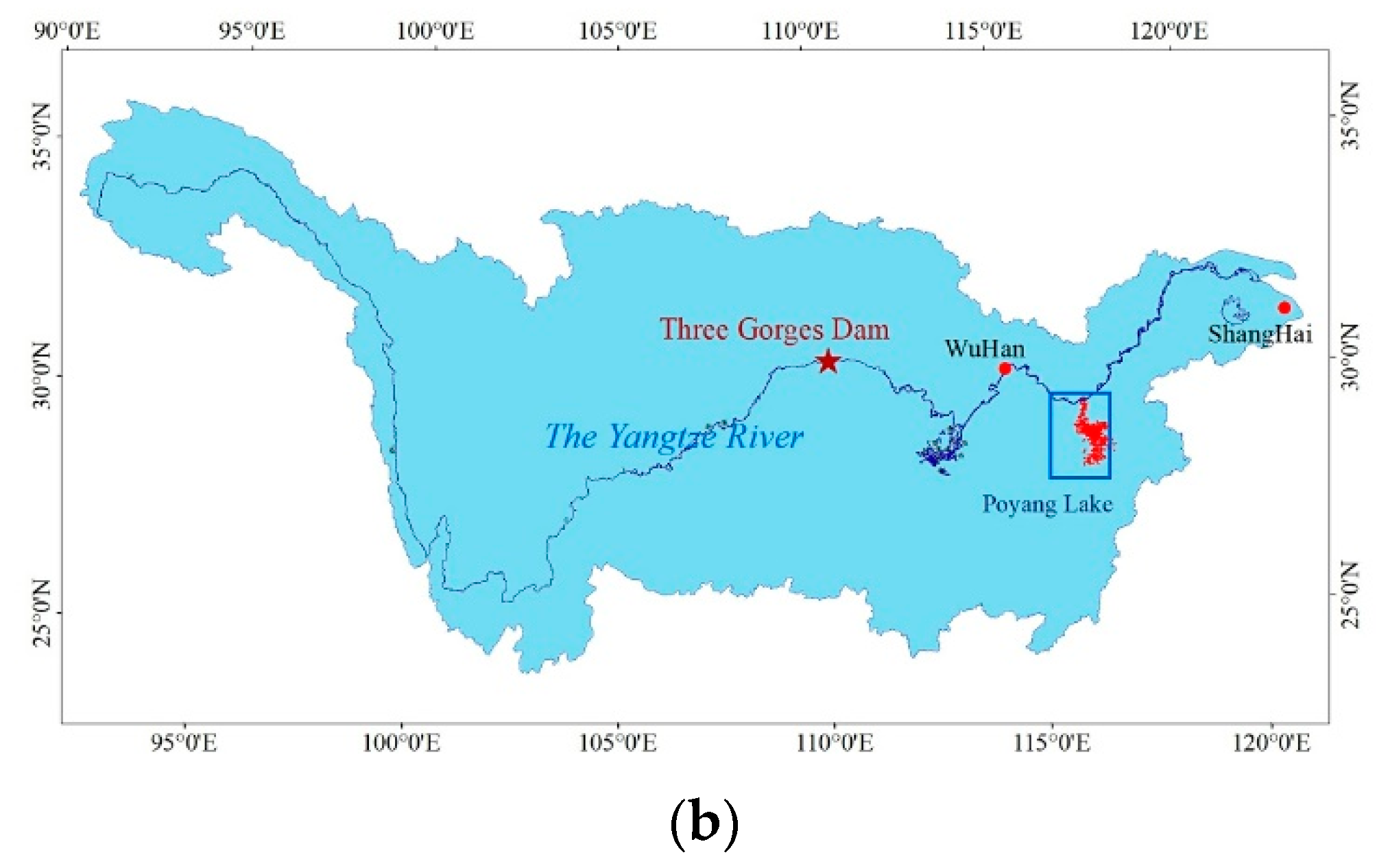

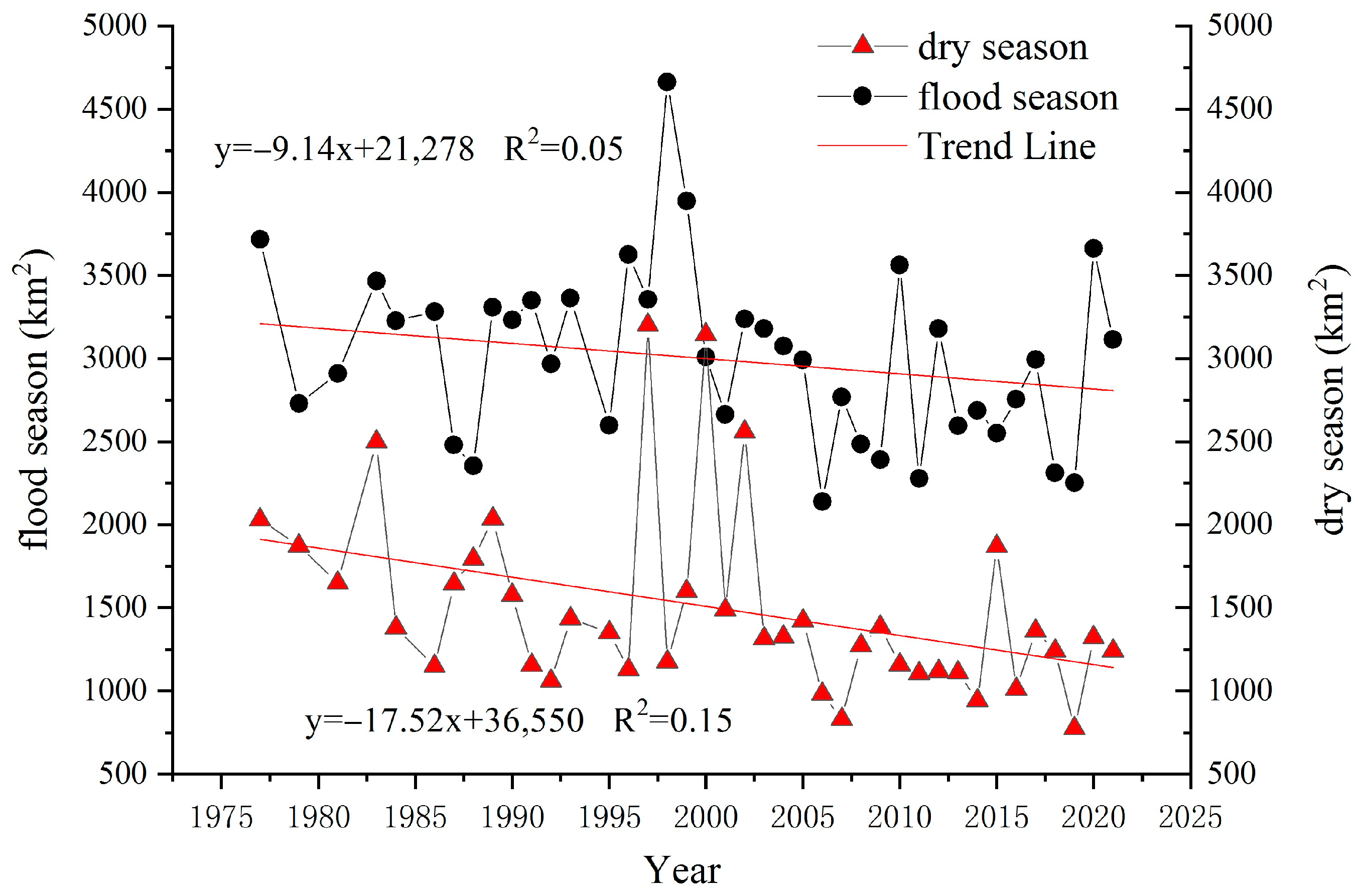
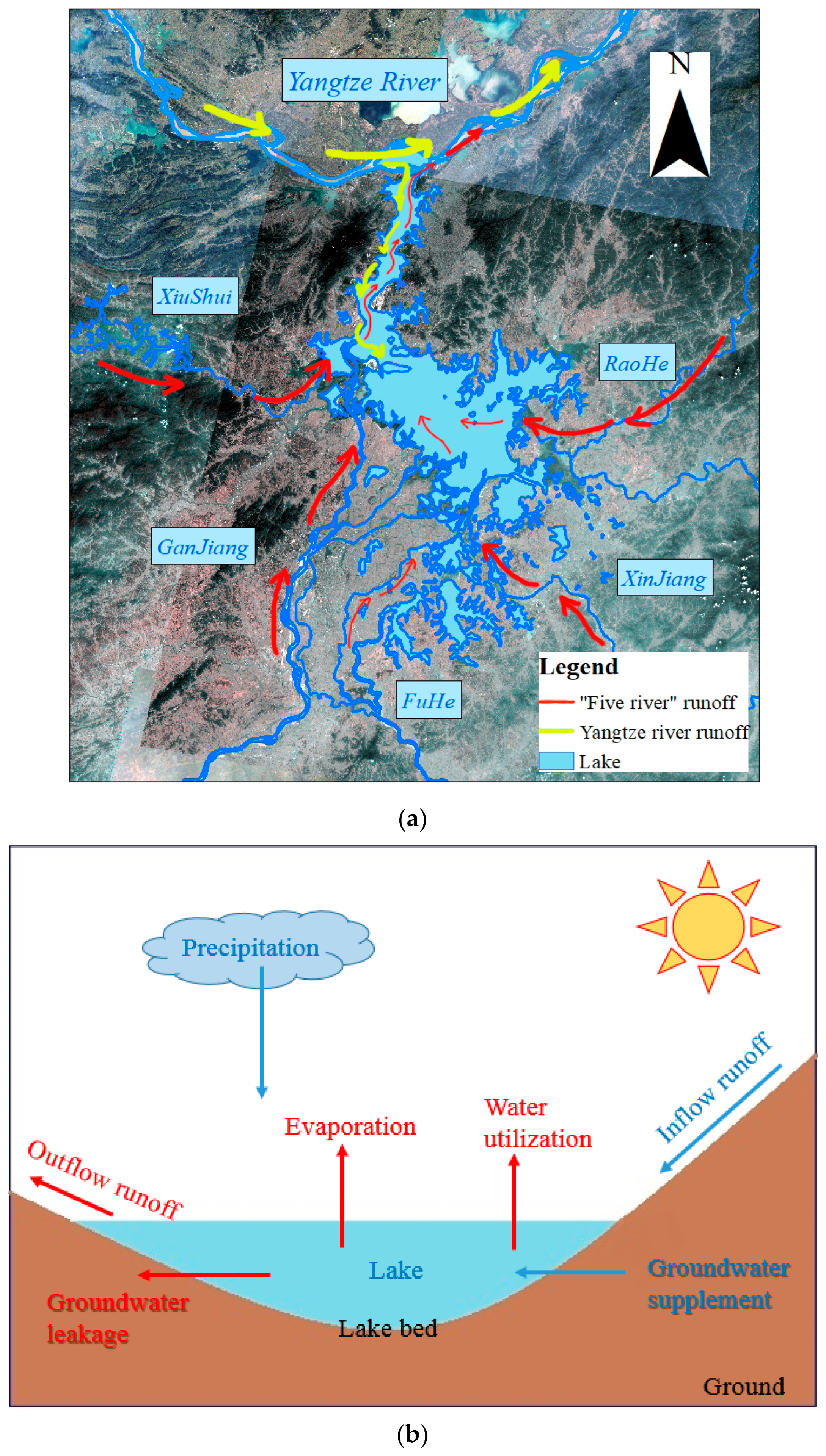



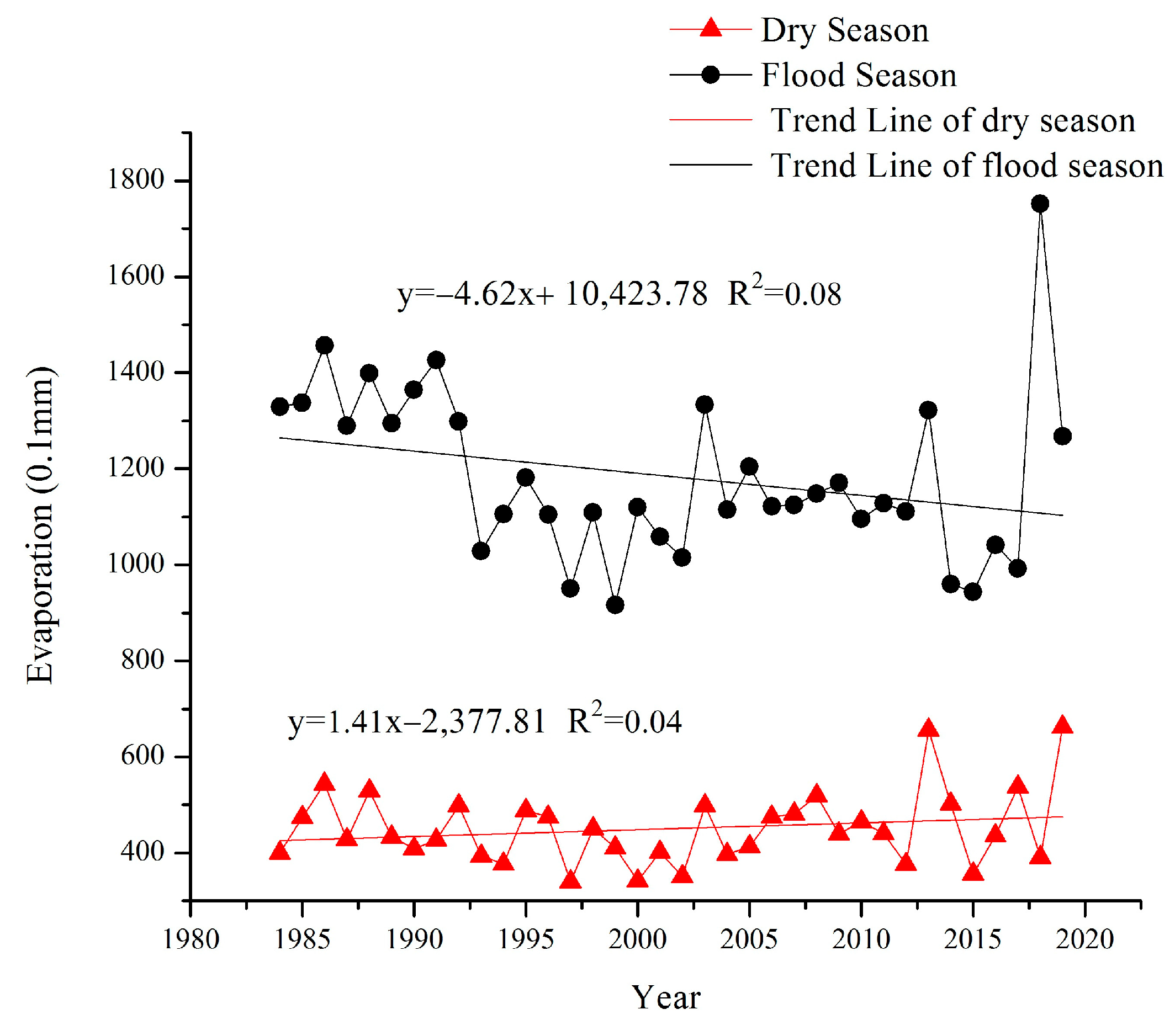

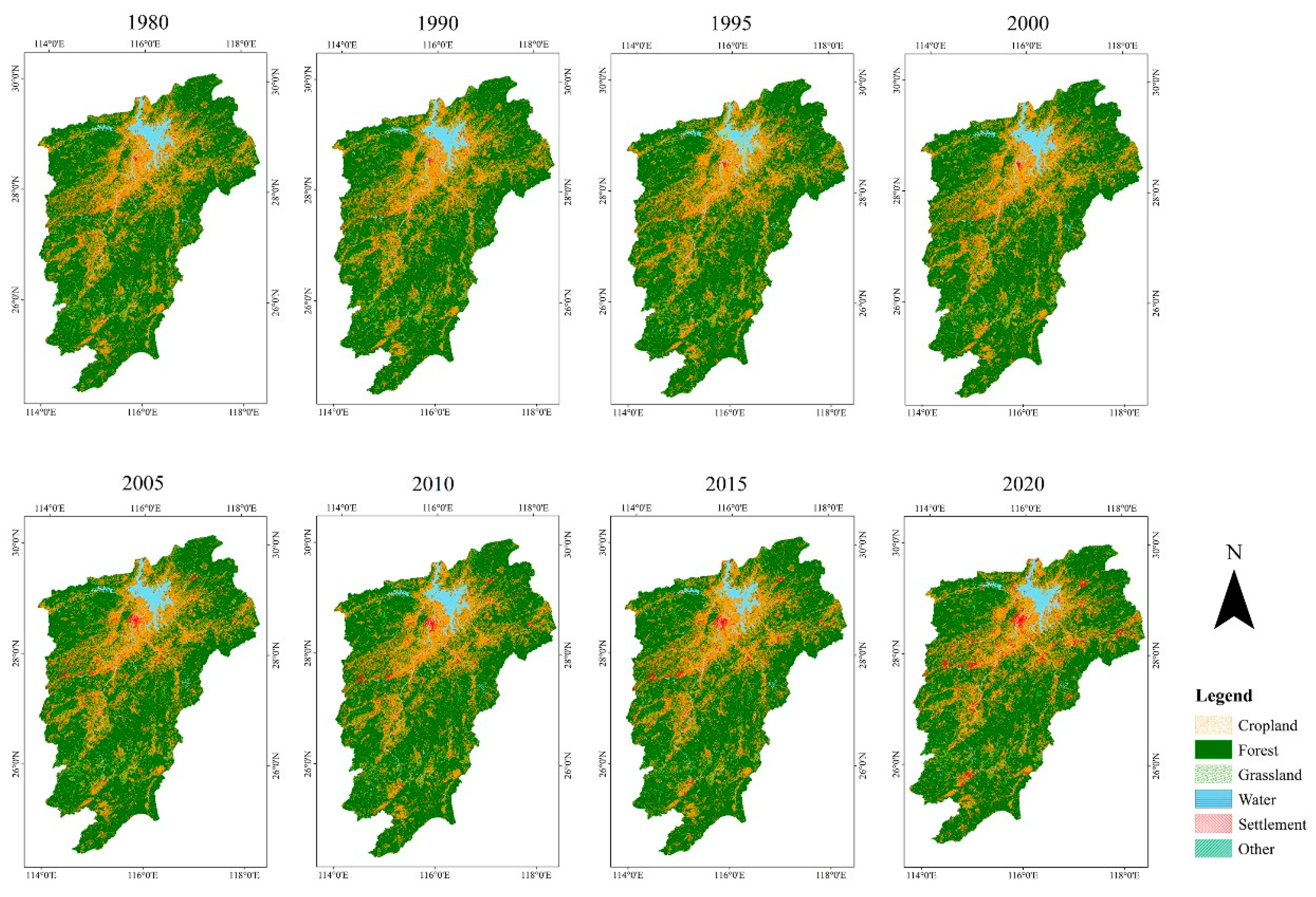
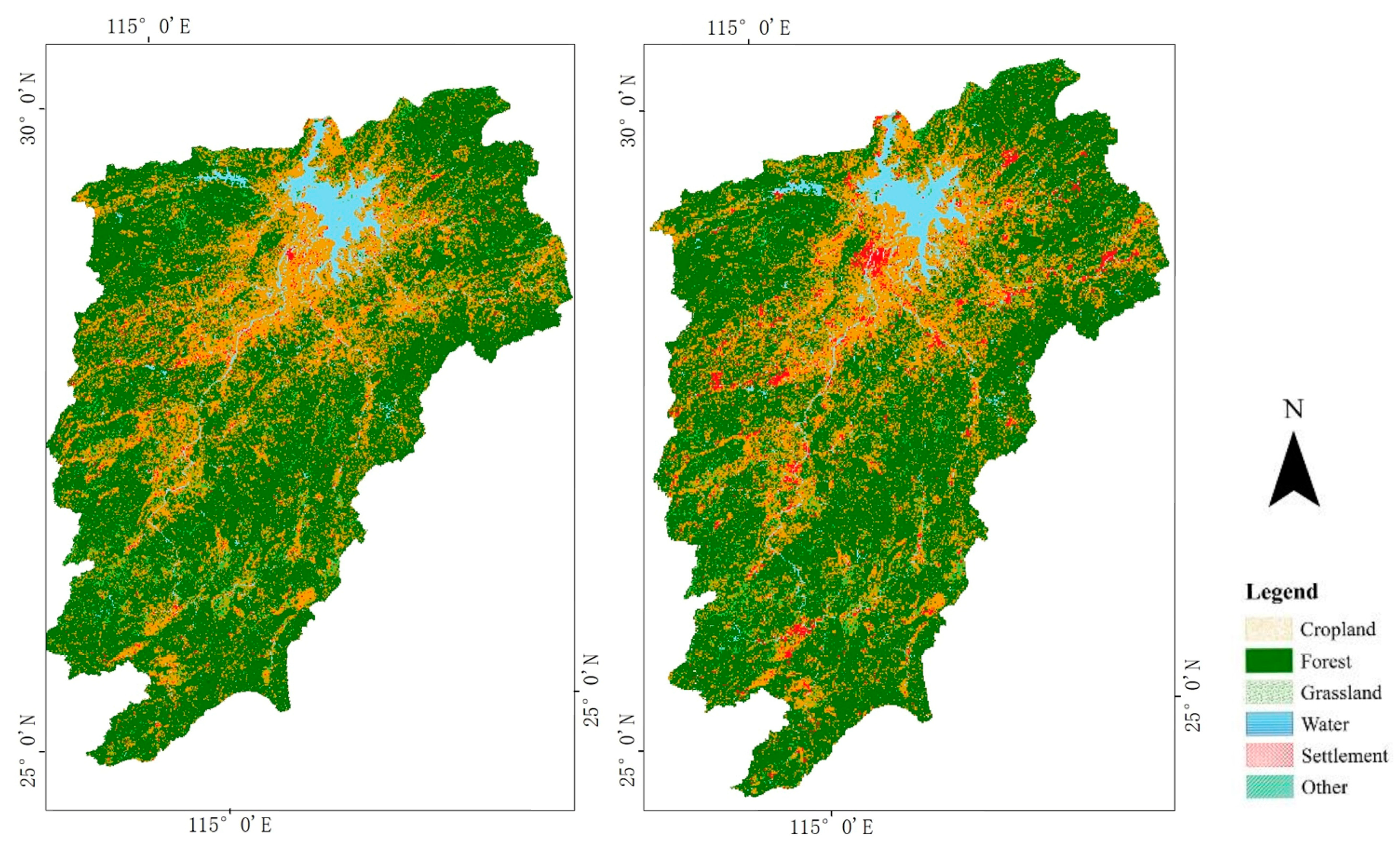
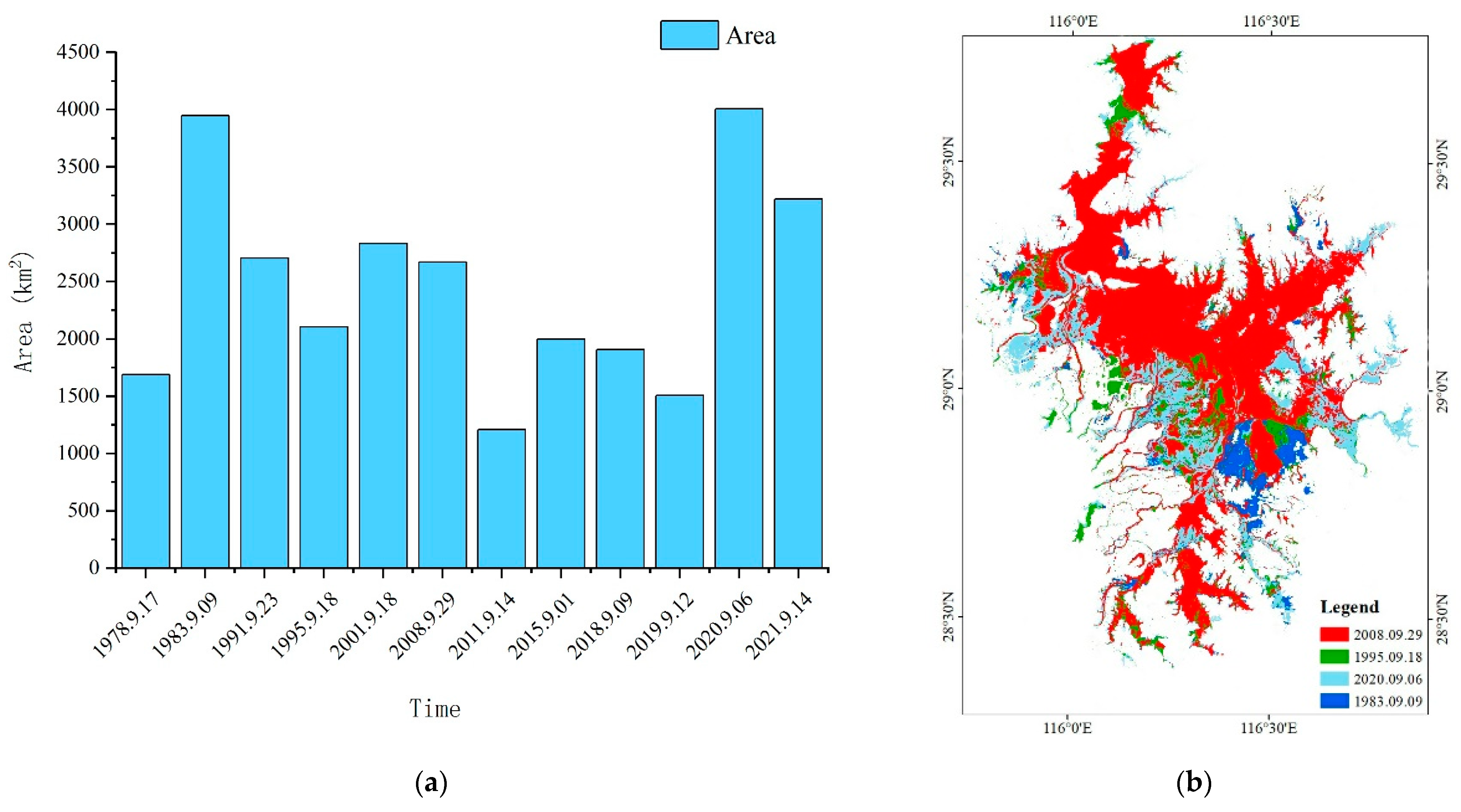
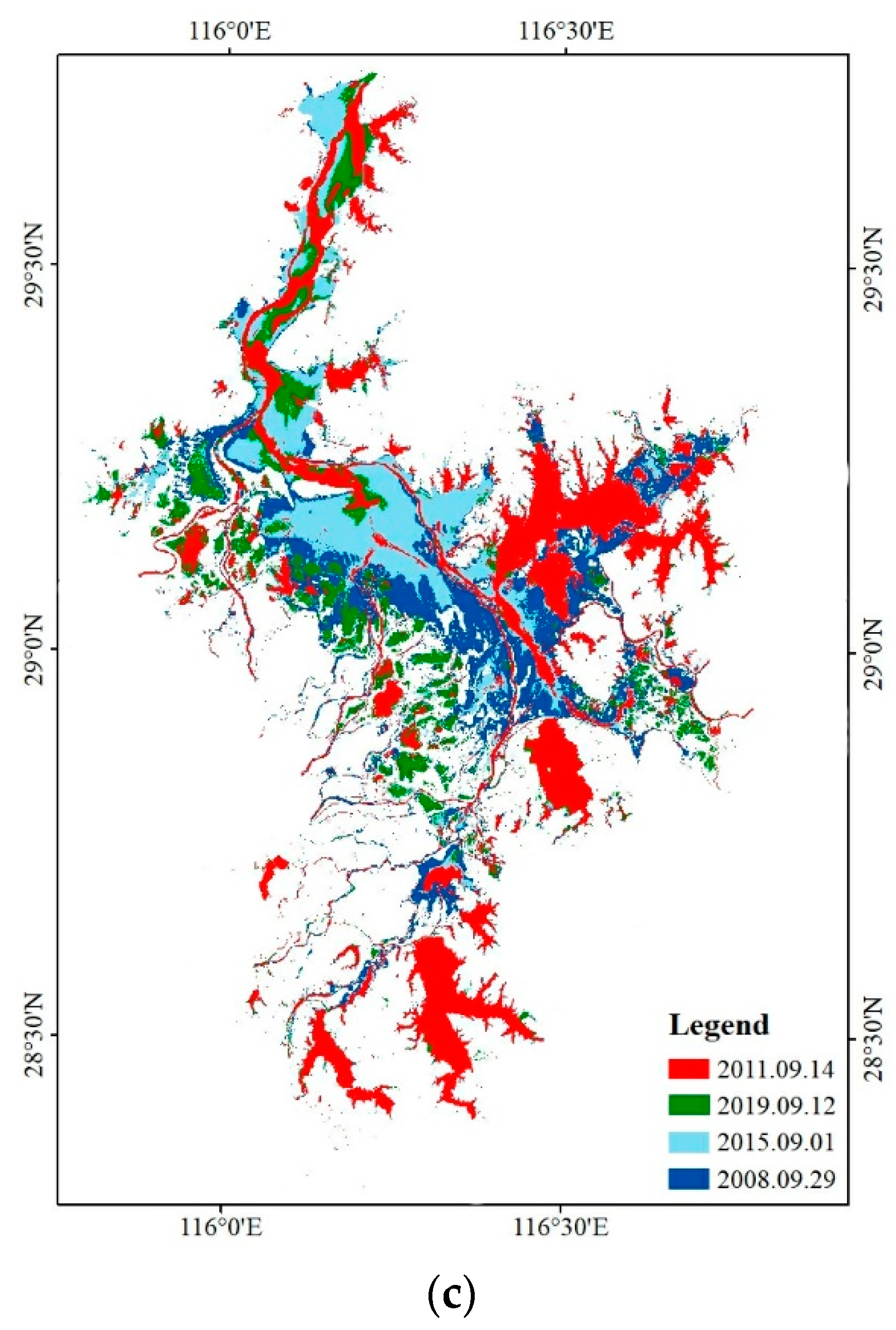
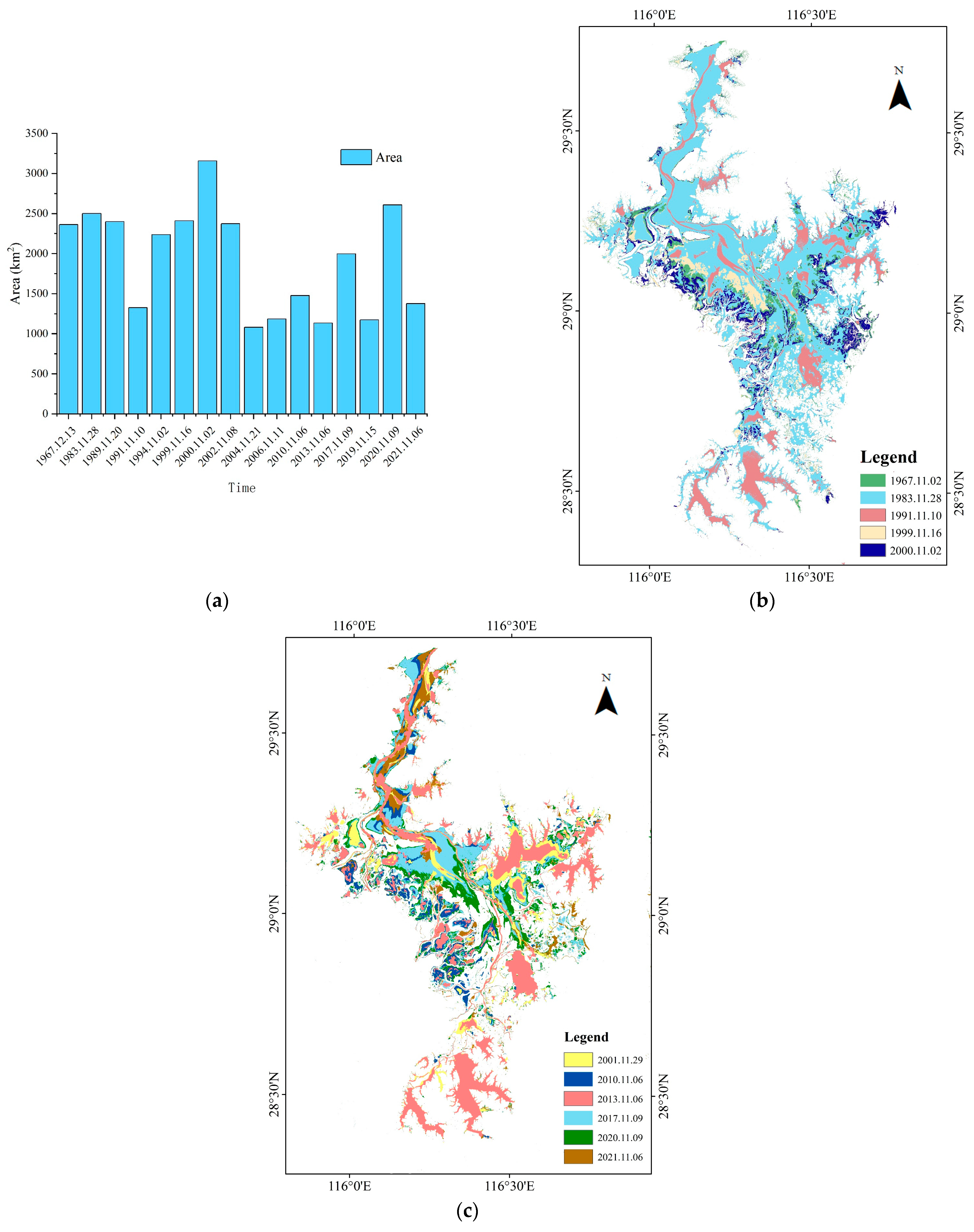
| Flood Season | ||
| Variable | Factor1 | Factor2 |
| Inflow | 0.86 | −0.02 |
| Net outflow | 0.85 | 0.03 |
| Sediment | 0.83 | −0.02 |
| Precipitation | −0.55 | 0.77 |
| Evaporation | 0.58 | 0.72 |
| Dry Season | ||
| Variable | Factor1 | Factor2 |
| Net outflow | 0.88 | 0.03 |
| Inflow | 0.77 | 0.56 |
| Sediment | 0.72 | 0.03 |
| Evaporation | −0.48 | 0.47 |
| Precipitation | −0.29 | 0.82 |
| Gain | Loss | Total Change | Swap | Absolute Value of Net Change | ||
|---|---|---|---|---|---|---|
| 1980–2000 | Cropland | 0.40 | 0.49 | 0.89 | 0.81 | 0.08 |
| Forest | 0.43 | 0.51 | 0.94 | 1.02 | −0.08 | |
| Grassland | 0.29 | 0.24 | 0.53 | 0.58 | −0.04 | |
| Other | 0.13 | 0.10 | 0.23 | 0.26 | −0.03 | |
| Settlement | 0.14 | 0.00 | 0.14 | 0.00 | 0.14 | |
| Water | 0.27 | 0.32 | 0.60 | 0.65 | −0.05 | |
| 2000–2020 | Cropland | 12.04 | 12.77 | 24.81 | 24.09 | 0.73 |
| Forest | 11.82 | 52.94 | 64.76 | 65.58 | −0.81 | |
| Grassland | 3.00 | 3.47 | 6.47 | 6.49 | −0.02 | |
| Other | 0.14 | 0.54 | 0.67 | 0.42 | 0.25 | |
| Settlement | 2.78 | 0.76 | 3.55 | 2.02 | 1.53 | |
| Water | 2.08 | 3.06 | 5.14 | 4.89 | 0.25 |
| Relative Difference (Increase) | 2020 | ||||||
| Cropland | Forest | Grassland | Other | Settlement | Water | ||
| 1980 | Cropland | 0.00 | 0.07 | 0.04 | −0.43 | 1.26 | 0.08 |
| Forest | −0.10 | 0.00 | 0.01 | −0.94 | −0.55 | −0.31 | |
| Grassland | 0.26 | 0.38 | 0.00 | −0.60 | −0.25 | −0.45 | |
| Other | −0.44 | −0.93 | −0.60 | 0.00 | −0.52 | 10.79 | |
| Settlement | 2.36 | −0.48 | −0.13 | 0.38 | 0.00 | −0.04 | |
| Water | 0.44 | −0.58 | −0.35 | 17.87 | 0.25 | 0.00 | |
| Relative Difference (Reduced) | 2020 | ||||||
| Cropland | Forest | Grassland | Other | Settlement | Water | ||
| 1980 | Cropland | 0.00 | −0.15 | 0.18 | −0.50 | 2.24 | 0.28 |
| Forest | 0.06 | 0.00 | 0.39 | −0.94 | −0.22 | −0.57 | |
| Grassland | 0.10 | −0.02 | 0.00 | −0.69 | −0.05 | −0.16 | |
| Other | −0.53 | −0.95 | −0.61 | 0.00 | −0.41 | 17.93 | |
| Settlement | 1.54 | −0.68 | −0.24 | −0.06 | 0.00 | 0.50 | |
| Water | 0.87 | −0.56 | −0.02 | 21.12 | 1.39 | 0.00 | |
Disclaimer/Publisher’s Note: The statements, opinions and data contained in all publications are solely those of the individual author(s) and contributor(s) and not of MDPI and/or the editor(s). MDPI and/or the editor(s) disclaim responsibility for any injury to people or property resulting from any ideas, methods, instructions or products referred to in the content. |
© 2023 by the authors. Licensee MDPI, Basel, Switzerland. This article is an open access article distributed under the terms and conditions of the Creative Commons Attribution (CC BY) license (https://creativecommons.org/licenses/by/4.0/).
Share and Cite
Tian, B.; Gao, P.; Mu, X.; Zhao, G. Water Area Variation and River–Lake Interactions in the Poyang Lake from 1977–2021. Remote Sens. 2023, 15, 600. https://doi.org/10.3390/rs15030600
Tian B, Gao P, Mu X, Zhao G. Water Area Variation and River–Lake Interactions in the Poyang Lake from 1977–2021. Remote Sensing. 2023; 15(3):600. https://doi.org/10.3390/rs15030600
Chicago/Turabian StyleTian, Biqing, Peng Gao, Xingmin Mu, and Guangju Zhao. 2023. "Water Area Variation and River–Lake Interactions in the Poyang Lake from 1977–2021" Remote Sensing 15, no. 3: 600. https://doi.org/10.3390/rs15030600
APA StyleTian, B., Gao, P., Mu, X., & Zhao, G. (2023). Water Area Variation and River–Lake Interactions in the Poyang Lake from 1977–2021. Remote Sensing, 15(3), 600. https://doi.org/10.3390/rs15030600








